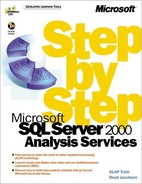0%
78Chapters
0-1Hours read
0kTotal Words
Book Description
This title shows how to build applications that take advantage of the powerful data-analysis services in Microsoft® SQL Server® 2000. You’ll discover why these services make it easier to analyze huge amounts of data quickly.
Table of Contents
- Copyright
- Preface
- Acknowledgments
- Administration Fundamentals
- Multidimensional Expressions
- Advanced Administration
- Index
